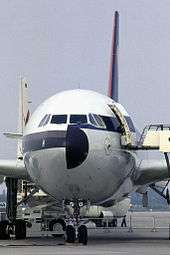Airbus A310
The Airbus A310 is a wide-body airliner developed and manufactured by Airbus, then a consortium of European aerospace manufacturers. Airbus had demand for an aircraft smaller than the A300, the first Twinjet wide-body. On 7 July 1978, the A310 (initially the A300B10) was launched with orders from Swissair and Lufthansa. On 3 April 1982, the first prototype conducted its maiden flight and it received its type certification on 11 March 1983.
| A310 | |
|---|---|
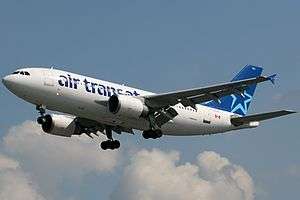 | |
| An A310, gear and flaps extended, from Air Transat, formerly one of its largest operators | |
| Role | Wide-body jet airliner |
| National origin | Multinational[1] |
| Manufacturer | Airbus |
| First flight | 3 April 1982 |
| Introduction | April 1983 with Swissair |
| Status | In limited service |
| Primary users | Mahan Air Air Transat (historical) Yemenia Iran Air |
| Produced | 1983–1998 |
| Number built | 255[2] |
| Developed from | Airbus A300 |
| Variants | Airbus A310 MRTT Airbus CC-150 Polaris |
Keeping the same eight-abreast cross-section, the A310 is 6.95 m (22.8 ft) shorter than the initial A300 variants, and has a smaller 219 m2 (2,360 sq ft) wing, down from 260 m2 (2,800 sq ft). The A310 introduced a two-crew glass cockpit, later adopted for the A300-600 with a common type rating. It was powered by the same General Electric CF6-80 or Pratt & Whitney JT9D then PW4000 turbofans. It can seat 220 passengers in two classes, or 240 in all-economy, and can fly up to 5,150 nmi (9,540 km). It has overwing exits between the two main front and rear door pairs.
In April 1983, the aircraft entered revenue service with Swissair and competed with the Boeing 767-200, introduced six months before. Its longer range and ETOPS regulations allowed it to be operated on transatlantic flights. Until the last delivery in June 1998, 255 aircraft were produced, as it was succeeded by the larger Airbus A330-200. It has cargo aircraft versions, and was developed into the Airbus A310 MRTT military tanker/transport.
Development
Background
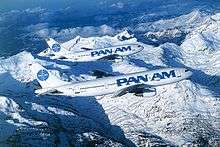
On 26 September 1967, the British, French, and West German governments signed a Memorandum of Understanding to commence the joint development of the 300-seat Airbus A300.[3][4][5] This collaborative effort resulted in the production of the consortium's first airliner, known as the Airbus A300. The A300 was a wide-body medium-to-long range passenger liner; it holds the distinction of being the first twin-engine wide-body aircraft in the world.[6][7][8][9] The design was relatively revolutionary for its time and featured a number of industry firsts, making the first use of composite materials on a commercial aircraft; during 1977, the A300 became the first ETOPS-compliant aircraft, which was made possible due to its high performance and safety standards.[10] The A300 would be produced in a range of models and sold relatively well to airlines across the world, eventually reaching a total of 816 delivered aircraft during its production life.[11]
During the development of the earlier A300, a range of different aircraft size and capacity were studied by the consortium; the resulting Airbus A300B proposal was one of the smaller options. When the A300B1 prototypes emerged, a number of airlines issued requests for an aircraft with greater capacity, which resulted in the initial production A300B2 version. As the A300 entered service, it became increasingly apparent that there was also a sizable market for a smaller aircraft; some operators did not have enough traffic to justify the relatively large A300, while others wanted more frequency or lower aircraft-mile costs at the expense of higher seat-mile cost (specifically Swissair and Lufthansa). At the same time, there was great pressure for Airbus to validate itself beyond the design and manufacture of a single airliner. In response to these desires, Airbus explored the options for producing a smaller derivative of the A300B2.[12]
Jean Roeder, chief engineer of Deutsche Airbus, speaking of the A310[8]
In order to minimise the associated research & development costs for the tentative project, Airbus chose to examine several early design studies performed during the A300 program. The company ultimately chose to prioritise its focus on one option, which became known as the A300B10MC (standing for Minimum Change). As envisioned, the airliner's capacity was reduced to a maximum of 220 passengers, which was viewed at the time as being a desired capacity amongst many airlines. However, such a design would have resulted in a relatively small fuselage being mated to a comparatively large wing and oversized undercarriage; such an arrangement would have, amongst other things, made the aircraft consume an unnecessarily larger amount of fuel as it carried heavier weight than what was otherwise required.[13]
Another problem for the program was presented in the form of inflation, the rate of which in the United Kingdom (one of the early members of the Airbus consortium) was around 35 per cent during 1979–80. This factor was responsible for significantly raising the program's development costs and, as a knock-on effect, increase the per-unit cost of the resulting airliner.[13] During the development of the A300, British manufacturer Hawker Siddeley Aviation (HSA) had been appointed as the subcontractor to perform the manufacturing of the wing of the aircraft; shortly afterwards, the British government chose to withdraw from the newly formed venture during 1969. During 1977, HSA subsequently merged with three other British aircraft companies, resulting in the formation of British Aerospace (BAe). By this point, the British government had publicly indicated its intentions to rejoin the Airbus program. During May 1976, the French government entered into a series of discussions on cooperation, during which its representatives stated that the placing of an order by British Airways (BA) was a condition for the re-admission of the United Kingdom into Airbus Industrie as a full partner.[14]
However, both BA and Rolls-Royce had not relinquished their will to collaborate with the Americans in future aircraft endeavours and, in BA's case, procure American aircraft. During the late 1970s, BA sought to purchase two separate types of aircraft in development by American company Boeing, initially known as the 7N7 and 7X7, which would develop into the 757 and 767, the latter of which being an intended rival to the upcoming A310, as well as the existing Boeing 747. Independent of the British government, BAe commenced its own dialogue between itself and American aircraft manufacturers Boeing and McDonnell Douglas for the purpose of assessing if BAe could participate any of their future programs, although the company's chairman, Lord Beswick, publicly stated that the overall aim of the firm was to pursue collaboration in Europe.[14] At the 1978 Farnborough Air Show, Eric Varley, the British Secretary of State for Industry, announced that BAe was to rejoin Airbus Industrie and participate as a full partner from 1 January 1979 onwards. Under the negotiated arrangement, BAe would be allocated a 20 per cent shareholding in Airbus Industrie and would perform "a full part in the development and manufacturing of the A310".[15]
Design effort
From late 1977, prior to the Varley announcement, BAe had already commenced work on the design of the new wing at its facility in Hatfield. However, due to negotiations with Britain on its return to the Airbus consortium being protracted, alternative options were explored, including potentially manufacturing the wing elsewhere.[8] At the same time as the British efforts, French aerospace firm Aérospatiale, German aircraft manufacturer Messerschmitt-Bölkow-Blohm (MBB) and Dutch-German joint venture company VFW-Fokker were also conducting their individual studies into possible options for the wing of the prospective airliner.
At the April 1978 Hanover Air Show, Airbus exhibited a model of the proposed A310. Its wing area, at 219.25 m2 (2,360.0 sq ft) was slightly larger than that studied, at 209 m2 (2,250 sq ft); its passenger cabin was 12 frames shorter than the A300,Note 2 accommodating typical passenger loads of 195 in two-class, or 245 in economy.[15] However, during the next 12 months, almost every aspect was further refined. On 9 June 1978, Swissair and Lufthansa developed a joint specification for the aircraft, and within a month, announced that they would place the launch orders. On 15 March, Swissair became the first airline to place a firm order for the type, announcing that it would acquire 10 with a further 10 under option to replace its McDonnell Douglas DC-9s on its major intra-European routes. Lufthansa was quick to place a $240 million 10-aircraft order; additional orders from French operator Air France and Spanish airline Iberia shortly followed.[15]
As a consequence of increasingly strong interest in the tentative airliner, coupled with the recovery of the industry during the late 1970s, contributed to Airbus deciding to launch the A300B10, which was now known as the A310, into production on 7 July 1978. During the latter half of 1978, an order for 10 A300s was placed by independent British airline Laker Airways, satisfying Airbus's demand for the placing of a British order for their aircraft.[8] On 1 April 1979, Lufthansa decided to raise its commitment for the type to 25 orders, along with 25 options. Two days later, Dutch operator KLM signed its order for 10 orders and 10 options at £238 million.[15][16][17] On 6 July 1979, Air France announced that it had raised its order from 4 to 35 airliners. Other airlines announcing orders for the A310 during 1979 included Martinair, Sabena and Air Afrique.[16][17]
Initially, a pair of distinct versions of the A310 had been planned by Airbus; the regional A310-100 and the transcontinental A310-200. The A310-100 featured a range of 2,000 nmi (3,700 km) with 200 passengers, whilst the A310-200 possessed a higher MTOW and centre section fuel, being able to carry the same load a further 1,000 nmi (1,900 km).[18] Basic engines offered for the type included the General Electric CF6-45B2 and Pratt & Whitney JT9D-7R4. At one point, British engine manufacturer Rolls-Royce was openly considering offering an engine for the A310, the Rolls-Royce RB.207, however, it ultimately chose to discard such efforts in favour of a smaller three-spool design, the RB.211.
Production
_-_53Fi2063_-_cropped.jpg)
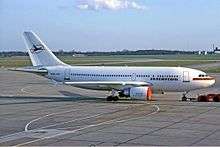
The range of the A310 exceeds that of the A300 series with the exception of the A300-600R, which in turn surpasses that of the A310-200. The greater range of the A310 contributed to the airliner being used extensively by operators on transatlantic routes. The A300 and A310 introduced the concept of commonality: A300-600 and A310 pilots can cross-qualify for the other aircraft with one day of training.
Sales of the A310 continued through the early 1980s. On 3 April 1982, the prototype A310-200 airliner conducted its maiden flight; by this point, the type had accumulated a combined orders and options for 181 aircraft, which had been placed by 15 airlines worldwide, which had been a relatively superior start than that of the original A300. Over time, it had become clear that the longer-range series −200 aircraft was the more popular of the two models on offer. During 1979, in response to the lack of demand for the A310-100, Airbus decided stop offering the lower gross weight model which had been originally proposed for Lufthansa; as a consequence, none of this variant were ultimately manufactured.[16]
During the early 1990s, demand for the aircraft began to slacken; there were no new A310 passenger orders placed during the late 1990s, in part due to the introduction of the newer and more advanced Airbus A330 during this time. As a result, during June 1998, the last delivery of the A310 was completed. The A310, along with its A300 stablemate, officially ceased production during July 2007, though an order from Iraqi Airways for five A310s had remained on the books until July 2008. The remaining freighter sales were to be instead fulfilled by the new A330-200F derivative.[19]
The A310 has been commonly marketed as an introduction to wide-body operations for airlines based in developing countries. The airliner was replaced in Airbus' lineup by the highly successful A330-200, which shares its fuselage cross-section. Between 1983 and the last aircraft produced in 1998, 255 A310s were delivered.[2] The A300 and A310 established Airbus as a competitor to Boeing and allowed it to go ahead with the more ambitious A320 and A330/A340 families.
As of July 2017, 37 A310s remain in commercial service; major operators are Air Transat and Mahan Air with 9 aircraft each; Fedex Express (6), and 7 airlines operating 13 aircraft between them.[20]
The Royal Canadian Air Force currently operates a fleet of 5 Airbus CC-150 Polaris, civilian Airbus A310-300s, originally owned by Wardair, and subsequently Canadian Airlines International, after the airlines merged. The aircraft were then sold to the Canadian Government and have been converted for use as the primary long distance transport aircraft as part of the Royal Canadian Air Force's fleet of Royal Canadian Air Force VIP aircraft.
Design
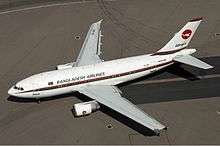

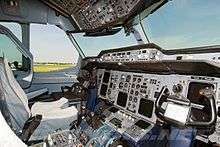
The Airbus A310 was a medium- to long-range twin-engined wide-body airliner. Initially a derivative of the A300, the aircraft had originally been designated the A300B10. It was essentially a shortened variant of the earlier aircraft; however, there were considerable differences between the two aircraft.[21] Specifically, the fuselage possessed the same cross-section but being shorter than the A300, it provided capacity for a typical maximum of 200 passengers. The rear fuselage was heavily re-designed, featuring altered tapering, while involved a move aft of the rear bulkhead to create additional capacity; this same design change was later transferred back to later variants of the A300, such as the A300-600 and A330/A340 fuselages.[21] The A310 also had a different emergency exit configuration, consisting of four main doors (two at the front and two at the rear of the aircraft), and two smaller doors over the wings.
The wing of the A310 was redesigned, possessing a reduced span and wing area and incorporating simpler single-slotted Fowler flaps designed by British Aerospace shortly following its decision to join the Airbus consortium.[21] Other changes to the wing included the elimination of the outer ailerons, which were occasionally referred to by the manufacturer as being "low speed ailerons", and the addition of electrically-actuated spoilers. The wing also featured common pylons, which were able to support all types of engines that were offered to customers to power the airliner.[21] From 1985 onwards, later-built production A310s were equipped with wingtip fences for the purpose of reducing lift-induced drag. A limited number of alternations were also performed to the airliner's tail unit, such as the adoption of smaller horizontal tail surfaces.[21]
The A310 was furnished with a two-crew glass cockpit configuration as standard, removing the requirement for a flight engineer; Airbus referred to this concept as the Forward-Facing Crew Cockpit.[8] The company had developed the cockpit to significantly enhance the aircraft's man-machine interface, thereby improving operational safety. It was outfitted with an array of six computer-based CRT displays to provide the flight crew with centralised navigational, warning, monitoring, and general flight information in place of the more traditional analogue instrumentation and dials, which were used in conjunction with a range of modern electronic systems.[8] The same flight deck had been incorporated into the A300-600, a move which increased commonality between the two types and enabled a dual type rating to be achieved, this same approach was later used on many future Airbus aircraft. In addition to the two flying crew, provisions for third and fourth crew seats were present upon the flight deck.[8]
The A310 was initially launched with a choice of three engines – the General Electric CF6-80A (originally the CF6-45B2), the Pratt & Whitney JT9D-7R4D1 and the Rolls-Royce RB211-524B4. The specific Rolls-Royce RB211-524B4 engine intended for this initial application was not developed. General Electric powered A310-200s were originally offered with the CF6-80A3 (A310-203), but with the introduction of the A310-300, the CF6-80C2 became available for both variants. The initial offering was for the 53,000 pounds-force (240 kN) CF6-80C2A2 (A310-204/A310-304) engine and later on the higher thrust 59,000 pounds-force (260 kN) 80C2A8 (A310-308). Similarly Pratt & Whitney powered A310s were first offered with versions of the JT9D engines (both −22s and −300s) but when the PW4000 powered A310 became available in 1987, the aircraft was offered with the 52,000 pounds-force (230 kN) PW4152 (A310-324). From April 1992 the higher thrust PW4156A 56,000 pounds-force (250 kN) was offered for the A310 (A310-325), with the PW4158A 58,000 pounds-force (260 kN) /-326 becoming available from 1996.
The A310 was equipped with a modified undercarriage, derived from the A300; the landing gear were outfitted with carbon brakes, which were fitted as standard.[21] The structure of the airliner featured a high level of composite materials throughout both primary and secondary structures, increased beyond that of the earlier A300. The A310 is outfitted with integrated drive electrical generators along with auxiliary power unit, which were improved versions of those used on the A300.[21]
Variants
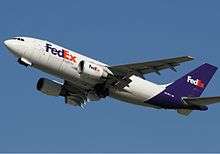
_C-GLAT_-_MSN_588_(9510329329).jpg)
The A310 is available in two basic versions, the medium range −200 and the longer range −300. The first version of the aircraft to be developed was the −200 but this was later joined by the −300 which then became the standard production version of the aircraft. The short range -100 variant was never developed due to low demand.
- A310-200
- The first A310, the 162nd Airbus off the production line, made its maiden flight on 3 April 1982 powered by the earlier Pratt & Whitney JT9D-7R4D1 engines. The −200 entered service with Swissair and Lufthansa a year later. Late series −200 also featured wing fences identical to those of the −300. The first three A310s were initially fitted with outboard ailerons; they were later removed once testing showed them to be unnecessary.[22]
- A310-200C
- A convertible version, the seats can be removed and cargo placed on the main deck.
- A310-200F
- The freight version of the A310-200 available as a new build or as a conversion of the existing wide-bodied aircraft. The A310-200F freighter can carry 39t of freight for 5,950 km.[23] No production freighters of the A310-200F were produced.
- A310-300
- First flown on 8 July 1985, the −300 is dimensionally identical to the −200, although it provides an increased Maximum Take-Off Weight (MTOW) and an increase in range, provided by additional centre and horizontal stabilizer (trim-tank) fuel tanks. This model also introduced wingtip fences to improve aerodynamic efficiency, a feature that has since been retrofitted to some −200s. The aircraft entered service in 1986 with Swissair. The A310-300 incorporates a computerised fuel distribution system which allows it to be trimmed in flight, optimising the centre of gravity by shuttling up to 5,000 kg (11,000 lb) of fuel in and out of the horizontal stabilizer tank, controlled by a Center of Gravity Control Computer.
- A310-300C
- A convertible passenger/cargo version, the seats can be removed and cargo placed on the main deck.
- A310-300F
- The freight version of the A310-300F. Operators such as FedEx Express acquired modified ex-passenger A310s, usually starting with the −300 version. No production freighters of the A310-300F were produced.
- A310 MRT/MRTT
- The A310 has been operated by several air forces as a pure transport (A310-300 MRTT), however several have now been converted to the "Multi Role Tanker Transport" configuration by EADS, providing an aerial refueling capability. At least six have been ordered; four by the German Air Force and two by the Canadian Armed Forces. Deliveries began in 2004. Three were converted at EADS EFW in Dresden, Germany; the other three at Lufthansa Technik in Hamburg, Germany.
A310 Zero G
- One A310 unit has been redesigned to become a scientific research laboratory dedicated to weightlessness. This reduced-gravity aircraft is used to realise parabolas allowing to perform 22 seconds of weightlessness. Operated by Novespace, subsidiary of CNES, French Space Agency, A310 Zero G is based on Bordeaux Mérignac airport.[24] It also performs scientific flights, recreational flights under the Air Zero G brand, and movie special effects, such as for The Mummy (2017).[25] Astronaut Thomas Pesquet is one of the Novespace A310 Zero G pilots.[26]
Operators
Civilian operators
As of April 2020, a small number of commercial airlines continue to use the A310:
- Passenger
- Ariana Afghan Airlines - 2 in service[27]
- Iran Air - 2 in service[28]
- Mahan Air - largest operator with 10 in service[29]
- Taban Air - 1 in service[30]
- Yemenia - 2 in service[31]
- Cargo
Military operators
%2C_Germany_-_Air_Force_JP7415094.jpg)
_Germany_-_Air_Force_10%2B22%2C_HAM_Hamburg_(Fuhlsbuttel)%2C_Germany_PP1189918738.jpg)
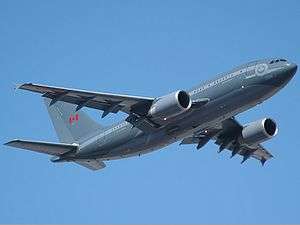
The A310 is also used by the armed forces of the following countries:
- Royal Canadian Air Force – designated CC-150 Polaris (originally ordered by Wardair and delivered to Canadian Airlines)
- French Air Force
- German Air Force
- Mongolian Air Force
- Pakistan Air Force
- Spanish Air Force
- Royal Thai Air Force
Deliveries
By the end of production, a total of 255 A310s had been ordered and delivered.[2]
| Total | 1998 | 1997 | 1996 | 1995 | 1994 | 1993 | 1992 | 1991 | 1990 | 1989 | 1988 | 1987 | 1986 | 1985 | 1984 | 1983 | |
|---|---|---|---|---|---|---|---|---|---|---|---|---|---|---|---|---|---|
| Deliveries | 255 | 1 | 2 | 2 | 2 | 2 | 22 | 24 | 19 | 18 | 23 | 28 | 21 | 19 | 26 | 29 | 17 |
Accidents and incidents
As of September 2015 there have been 12 hull-loss accidents involving A310s with a total of 825 fatalities; and 9 hijackings with a total of five fatalities.[34]
- 26 March 1991: Singapore Airlines Flight 117 carrying 123 passengers and crew, was hijacked by 4 male Pakistanis en route to Singapore. The aircraft landed at Singapore safely where the Singapore Armed Forces Commando Formation stormed it and killed the hijackers. None of the hostages were hurt.
- 31 July 1992: Thai Airways International Flight 311, an A310-304 carrying 99 passengers and 14 crew, crashed on approach to Tribhuvan International Airport, Kathmandu. All 113 on board were killed.
- 11 February 1993: Lufthansa Flight 592 carrying 94 passengers and 10 crew was hijacked by a 20-year-old Ethiopian man, Nebiu Demeke, at John F. Kennedy International Airport, New York City.
- 23 March 1994: Aeroflot Flight 593, an A310-300 carrying 63 passengers and 12 crew, crashed in Siberia after the pilot let his son sit at the controls and the autopilot partially disconnected. All 75 on board were killed.
- 31 March 1995: TAROM Flight 371, an A310-324 carrying 49 passengers and 11 crew, crashed near Otopeni International Airport, Bucharest, Romania after the throttle on the starboard engine jammed with no subsequent resolution by the pilots. All 60 on board were killed.
- 11 December 1998: Thai Airways International Flight 261 crashed near Surat Thani Airport in Thailand. There were 101 fatalities and 45 survived with serious injuries.
- 30 January 2000: Kenya Airways Flight 431, an A310-300 crashed in the Atlantic Ocean shortly after takeoff from Abidjan in Côte d'Ivoire. 169 passengers and crew were killed and 10 passengers survived with serious injuries. This is the deadliest aviation accident involving the Airbus A310.[35]
- 12 July 2000: Hapag-Lloyd Flight 3378, an A310-304, crashed during an emergency landing near Vienna in Austria due to fuel exhaustion. All 142 passengers and 8 crew on board survived.
- 6 March 2005: Air Transat Flight 961, an Airbus A310-308, en route from Cuba to Quebec City with nine crew and 261 passengers on board, experienced a structural failure in which the rudder detached in flight. The aircraft returned to Varadero, Cuba, where they made a safe landing. The crew made no unusual rudder inputs during the flight nor was the rudder being manipulated when it failed; there was no obvious fault in the rudder or yaw-damper system. Subsequent investigation determined that Airbus' inspection procedure for the composite rudder was inadequate; inspection procedures for composite structures on airliners were changed following this accident.
- 9 July 2006: S7 Airlines Flight 778, an Airbus A310-324 from Moscow carrying 196 passengers and eight crew, overshot the runway at Irkutsk in Siberia, plowed through a concrete barrier and caught fire as it crashed into buildings. Reports said that 70 of the 204 on board survived, with 12 missing.[36] Since the accident, casualty figures have fluctuated, in part due to three people boarding the aircraft who were not on the passenger manifest, and some survivors walking home after being assumed trapped in the wreckage.[37]
- 12 March 2007: Biman Bangladesh Airlines Flight 006, an A310-325 carrying 236 passengers and crew, suffered a collapsed nose gear during its takeoff run. Fourteen people suffered minor injuries in the accident at Dubai International Airport. The aircraft came to rest at the end of the runway and was evacuated, but blocked the only active runway and forced the airport to close for nearly eight hours. The aircraft was written off.[38]
- 10 June 2008: Sudan Airways Flight 109, an A310-324 from Amman, Jordan carrying 203 passengers and 11 crew, ran off the runway while landing at Khartoum International Airport during bad weather. Soon afterward a fire started in the aircraft's right wing area. A total of 30 people were killed.[39]
- 30 June 2009, Yemenia Flight 626, an A310-324 flying from Sana'a, Yemen, to Moroni, Comoros crashed into the Indian Ocean shortly before reaching its destination. The aircraft was carrying 153 passengers and crew; there was one survivor, a 14-year-old girl.[40][41]
Preserved aircraft

- ex-China Eastern Airlines A310-222 B-2301 preserved at the China Civil Aviation Museum near Beijing Capital International Airport
- ex-Nigeria Airways A310-222 5N-AUG is now the Italian restaurant All Italia in Gilly, about 5 km south of Brussels Charleroi Airport.
Specifications
| Model | A310-200 | A310-300 |
|---|---|---|
| Cockpit Crew | Two | |
| 2-class | 220 passengers (20F + 200Y)[43] | |
| 1-class | 237Y 8-abreast | 243Y 8-abreast / 265Y 9-abreast |
| Exit limit | 275 passengers[44] | |
| Lower deck | 14 LD3 containers | |
| Length | 46.66 m (153 ft 1 in) | |
| Height | 15.8 m (51 ft 10 in) fuselage | |
| Wing | 43.9 m (144 ft) span, 219 m2 (2,360 sq ft) area, 28 ° sweep[45] 8.8 aspect ratio | |
| Cross section | 5.64 m (18 ft 6 in) | |
| Maximum Payload | 32,834 kg (72,387 lb) | 37,293 kg (82,217 lb) |
| MTOW | 144,000 kg (317,466 lb) | 164,000 kg (361,558 lb) |
| OEW | JT9D: 77.4 t (171,000 lb), PW4000/CF6-80: 79.2 t (175,000 lb) | |
| Max fuel | 47,940 kg / 105 689 lb | |
| Engines | JT9D-7R4 / GE CF6-80 | JT9D-7R4E1 / PW4000 / CF6-80C2 |
| Thrust (×2) | 203.8–257.4 kN (45,800–57,900 lbf)[44] | |
| speed | Mach 0.8 (459 kn; 850 km/h) cruise,[46] Mach 0.84 (482 kn; 892 km/h) MMO[44] | |
| Ceiling | 41,100 ft (12,527 m)[44] | |
| Range | 3,500 nmi (6,500 km) [lower-alpha 1] | 5,150 nmi (9,540 km) [lower-alpha 2] |
Aircraft model designations
| Model | Certification Date | Engines |
|---|---|---|
| A310-203 | 11 March 1983 | GE CF6-80A3 |
| A310-203C | 27 November 1984 | GE CF6-80A3 |
| A310-204 | 23 April 1986 | GE CF6-80C2A2 |
| A310-221 | 11 March 1983 | PW JT9D-7R4D1 |
| A310-222 | 22 September 1983 | PW JT9D-7R4E1 |
| A310-304 | 11 March 1986 | GE CF6-80C2A2 |
| A310-308 | 5 June 1991 | GE CF6-80C2A8/A2 |
| A310-322 | 5 December 1985 | PW JT9D-7R4E1 |
| A310-324 | 27 May 1987 | PW4152 |
| A310-325 | 6 March 1992 | PW4156A |
See also
Related development
- Airbus A300
- Airbus A310 MRTT
- Airbus A330
- Airbus A340
- CC-150 Polaris
Aircraft of comparable role, configuration and era
Related lists
References
Citations
- Final assembly in France
- "Airbus - Historical Orders and Deliveries." Airbus S.A.S., January 2007. Retrieved: 10 December 2012,
- Simons 2014, p. 38.
- Endres 2004, p. 43.
- Pitt and Norsworthy 2012, p. 57.
- "Airbus at thirty - Family planning." Flight International, 2 January 2001.
- Senguttuvan 2006, p. 34.
- "Technology leaders (1977–1979)." Archived 25 September 2015 at the Wayback Machine Airbus, Retrieved: 3 March 2016.
- Pitt and Norsworthy 2012, pp. 57, 60.
- Simons 2014, p. 40.
- "Airbus – Historical Orders and Deliveries". Airbus S.A.S. January 2008. Archived from the original (Microsoft Excel) on 21 December 2008. Retrieved 10 December 2012.
- Gunston 2009, p. 85.
- Gunston 2009, p. 86.
- Gunston 2009, p. 87.
- Gunston 2009, p. 89.
- Flight International 27 October 1979 edition
- Airclaims Jet Programs 1995
- Gunston 2009, p. 91.
- "Airbus aims to fill freighter void with A330 derivative." Flight International, 14 March 2006.
- "World Census 2017". Flightglobal. Retrieved 28 June 2018.
- "A310 Europe builds on Airbus success." Flight International, 27 February 1982.
- Learmount, David (3 July 1982). "A310 keeps beating its targets". Flight International: 34. Retrieved 29 December 2015.
- "A310-200F Freight version." Aerospace Technology. Retrieved: 6 November 2011.
- "Zero-G flying means high stress for an old A310". Flightglobal.com. 23 March 2015. Retrieved 10 October 2017.
- "Tom Cruise en apesanteur dans l'A310 ZERO-G de Novespace" (in French). Retrieved 10 March 2018.
- "La reconversion (provisoire) de l'astronaute français Thomas Pesquet". FIGARO (in French). 21 February 2018. Retrieved 10 March 2018.
- "Global Airline Guide 2019 (Part One)". Airliner World: 4. October 2019.
- "Iran Air Fleet Details and History". Planespotters. 11 January 2020. Retrieved 11 January 2020.
- "Mahan Fleet". Mahan Air. Retrieved 26 November 2019.
- "Global Airline Guide 2019 (Part One)". Airliner World (October 2019): 17.
- "Global Airline Guide 2019 (Part Two)". Airliner World (November 2019): 42.
- https://www.planespotters.net/airline/Royal-Jordanian
- "2018 Q1 Board Activity Report" (PDF). Turkish Airlines. Retrieved 10 May 2018.
- "Airbus A310." Aviation Safety Net. Retrieved: 30 September 2015.
- Ranter, Harro. "ASN Aircraft accident Airbus A310-304 5Y-BEN Abidjan-Felix Houphouet Boigny Airport (ABJ)". www.aviation-safety.net. Retrieved 20 March 2019.
- "Russian plane's 'brakes failed'." BBC News, 9 July 2006. Retrieved: 10 April 2007.
- "Russian plane lost control upon landing." The New York Times, 10 July 2006. Retrieved: 11 April 2007.
- "ASN Aircraft accident Airbus A.310–325 S2-ADE Dubai Airport (DXB)." Aviation Safety Network. Retrieved: 6 November 2011.
- "30 people killed in Sudan Airways crash – statement." Sudan Tribune, 11 June 2008. Retrieved: 12 November 2010.
- "Yemenia Airbus black box found." stuff.co. Retrieved: 15 April 2015.
- Amir, Ahmed, Andrew Cawthorne and Jon Hemming. "Yemeni plane crashes in Comoros, 150 on board." Reuters, 29 June 2009. Retrieved: 30 June 2009.
- "A310 Airplane Characteristics for Airport Planning" (PDF). Airbus. December 2009.
- "Out-of-production / A310". Airbus.
- "Type Certificate Data Sheet" (PDF). EASA. 21 September 2017. Archived from the original (PDF) on 29 November 2018. Retrieved 29 November 2018.
- "Airbus Aircraft Data File". Civil Jet Aircraft Design. Elsevier. July 1999.
- "A310". Aircraft Technical Data & Specifications. Airliners.net.
Bibliography
- Endres, Günter (Spring 2004). "Classic Airliner: Airbus A300". Flightpath: The International Journal of Commercial Aviation. Norwalk, Connecticut, USA: AIRtime Publishing (Volume 3): 36–85. ISBN 1-880588-73-0.
- Gunston, Bill (February 2010). Airbus: The Complete Story. Sparkford, Yeovil, Somerset, UK: Haynes Publishing, 2009. ISBN 978-1-84425-585-6.
- Norris, Guy and Mark Wagner (1999). Airbus. St. Paul, Minnesota: MBI Publishing, 1999. ISBN 0-7603-0677-X.
- Pitt, Ivan L. and John Randolph Norsworthy. Economics of the U.S. Commercial Airline Industry: Productivity, Technology and Deregulation. "Springer", 2012. ISBN 1-4615-5031-9.
- Senguttuvan, P. S. Fundamentals of Air Transport Management. "Excel Books India", 2006. ISBN 81-7446-459-X.
- Simons, Graham. The Airbus A380: A History. "Pen and Sword", 2014. ISBN 1-78303-041-0.
- "World Airliner Census". Flight International, Volume 184, Number 5403, 13–19 August 2013, pp. 40–58.
Notes
- ^2 The fuselage is 14 frames (7.42m) shorter than the A300 fuselage, but the rear bulkhead was set 2 frames farther into the tailcone, so that only 12 frames of seating capacity were lost in the shortened version.
- ISA, LRC, JT9D, 237 passengers
- ISA, LRC, 240 passengers
External links
| Wikimedia Commons has media related to: |
